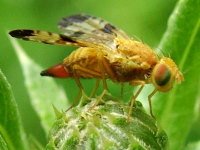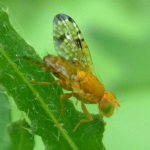Phylum Arthropoda (Arthropods) ➔ Subphylum Hexapoda (Hexapods) ➔ Class Insecta (Insects) ➔ Order Diptera (True flies) ➔ Family Tephritidae (Fruit flies)
Xyphosia miliaria (Schrank, 1781)
Distel-Bohrfliege Mottled Thistle Fly
Synonyms and other combinations:
Musca miliaria Schrank, 1781 | Musca arcuata Fabricius, 1781 | Oxyphora miliara Becker, 1905 | Trupanea sphaerocephali Schrank, 1803 | Trypeta meridionalis Costa, 1854 | Xyphosia balcanica Drensky, 1943 | Xyphosia cirsiorum Robineau-Desvoidy, 1830 |
Classification:
Xyphosia miliaria belongs to the subfamily Tephritinae, tribe Xyphosiini.Distribution:
Palearctic (Europe, Eastern Palearctic, Near East).Very common in large parts of Europe.
Habitat:
Preferably in forest areas, in semi-shady, rather humid places.Description:
The orange-yellow colored fly has a wing length of 3.7 - 6.3 mm. The wings are strikingly patterned. Males and females can be easily distinguished by looking at the abdomen. This ends in the females with an orange ovipositor with a dark tip. The rounded abdomen of the males appears shorter.Biology:
The Mottled Thistle Fly (Xyphosia miliaria) flies from the end of May to September.The oligophagous larvae develop in the flower heads of thistles, where they feed on achenes, pappi and receptacles. The host plants include field thistle (Cirsium arvense), marsh thistle (Cirsium palustre), common thistle (Cirsium vulgare), further Cirsium species, some Carduus species and the cotton thistle (Onopordum acanthium).
References, further reading, links:
- Pape T. & Thompson F.C. (eds) (2017). Systema Dipterorum (version 2.0, Jan 2011). In: Species 2000 & ITIS Catalogue of Life, 2017 Annual Checklist (Roskov Y., Abucay L., Orrell T., Nicolson D., Bailly N., Kirk P.M., Bourgoin T., DeWalt R.E., Decock W., De Wever A., Nieukerken E. van, Zarucchi J., Penev L., eds.). Digital resource at www.catalogueoflife.org/annual-checklist/2017. Species 2000: Naturalis, Leiden, the Netherlands. ISSN 2405-884X.
- Michael Drees: Die Bohr- und Schmuckfliegen des Raumes Hagen (Diptera: Tephritidae, Ulidiidae, Platystomatidae), Entomologische Zeitschrift, Schwanfeld, 126 (1) 2016, S. 47-57.
- Ian M. White (1988). Handbooks for the Identification of British Insects. Tephritid Flies. Diptera: Tephritidae. Vol: 10 - Part 5a. Royal Entomological Society of London.
- Plant Parasites of Europe
- Acidia cognata
- Anomoia purmunda
- Ceratitis capitata
- Chaetostomella cylindrica
- Dioxyna bidentis
- Ensina sonchi
- Myopites sp.
- Myopites stylatus
- Oxyna parietina
- Philophylla caesio
- Rhagoletis cerasi
- Tephritis cometa
- Tephritis conura
- Tephritis vespertina
- Terellia ruficauda
- Terellia serratulae
- Terellia tussilaginis
- Trupanea amoena
- Trupanea guimari
- Trypeta zoe
- Urophora cardui
- Urophora quadrifasciata
- Urophora stylata
- Xyphosia miliaria




